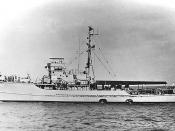Table of ContentsExecutive Summaryâ¦â¦â¦â¦â¦â¦â¦â¦â¦â¦â¦â¦â¦â¦â¦â¦â¦â¦â¦â¦â¦...Page 1Needs Assessmentâ¦â¦â¦â¦â¦â¦â¦â¦â¦â¦â¦â¦â¦â¦â¦â¦â¦â¦â¦â¦â¦â¦..Page 2Organizational Analysisâ¦â¦â¦â¦â¦â¦â¦â¦â¦â¦â¦â¦â¦â¦â¦â¦â¦â¦â¦â¦.Page 3Individual Analysis.â¦â¦â¦â¦â¦â¦â¦â¦â¦â¦â¦â¦â¦â¦â¦â¦â¦â¦â¦â¦â¦...Page 3Task Analysisâ¦â¦â¦â¦â¦â¦â¦â¦â¦â¦â¦â¦â¦â¦â¦â¦â¦â¦â¦â¦â¦â¦â¦â¦.Page 4Design a Training Programâ¦â¦â¦â¦â¦â¦â¦â¦â¦â¦â¦â¦â¦â¦â¦â¦â¦â¦â¦Page 4Developmentâ¦â¦â¦â¦â¦â¦â¦â¦â¦â¦â¦â¦â¦â¦â¦â¦â¦â¦â¦â¦â¦â¦â¦â¦..Page 6Implementationâ¦â¦â¦â¦â¦â¦â¦â¦â¦â¦â¦â¦â¦â¦â¦â¦â¦â¦â¦â¦â¦â¦â¦..Page 7Training Costs and Return on Investmentâ¦â¦â¦â¦â¦â¦â¦â¦â¦â¦â¦â¦â¦.Page 8Evaluationâ¦â¦â¦â¦â¦â¦â¦â¦â¦â¦â¦â¦â¦â¦â¦â¦â¦â¦â¦â¦â¦â¦â¦â¦â¦..Page 9Referencesâ¦â¦â¦â¦â¦â¦â¦â¦â¦â¦â¦â¦â¦â¦â¦â¦â¦â¦â¦â¦â¦â¦â¦â¦â¦..Page 10Executive SummaryCompanies must have an overall objective in order for any training to be effective, and at the same time the company will need to help fulfill their employees' personal goals by designing a training program for employees to utilize. According to the Metro PCS website, they offer wireless broadband personal communication services, or PCS, on a no long-term contract, flat rate, and unlimited usage basis in selected major metropolitan areas in the United States. Since the company launched their innovative wireless service in 2002, they have been among the fastest growing wireless broadband PCS providers in the United States as measured by growth in subscribers and revenues during that period. Metro PCS currently own or have access to wireless licenses covering a population of approximately 143 million in the United States. As of March 31, 2009 Metro PCS launched service in nine of the top 15 largest metropolitan areas and cover a licensed population of approximately 83 million. The company currently serves approximately 6.1 million total subscribers. Clearly Metro PCS' phone plans attract the customers but what about customer service and overall satisfaction? By using Metro PCS in the area of "poor customer satisfaction", we will look at what is involved in a training program for this company. There are four steps that Metro PCS would need to follow to create an effective systems approach in training:1)Make a needs assessment2)Design a training program3)Develop the program for a working environment and implement the developed training program4)Develop a system to evaluate the trainingBecause of the effectiveness of this four step process it has become popular causing other companies to use these steps in making up their system approach to training.
Needs AssessmentA needs assessment is the first step in the instructional design process. Needs assessment refers to the process used to determine if training is necessary (Noe, 2008). Why design and conduct a needs assessment? Metro PCS would need to consider the benefits of any intervention before they implement a program:- What learning will be accomplished?- What changes in behavior and performance are expected?- What are the expected economic costs and benefits of any projected solutions?Different organizations are often in a hurry to get new information out in order to make the money that is desired. The solution the company comes up with may not be the right solution; therefore, causing the company to spend countless time and money on something that may not work. This is one reason Metro PCS customer service has suffered.
A needs assessment involves three steps:1) Organizational Analysis2) Individual Analysis3) Task AnalysisOrganizational AnalysisOrganizational analysis involves determining the extent to which training is congruent with the company's business strategy and resources and if peers and managers are likely to provide the support needed for trainees to use training content in the work setting (Noe, 2008). This is one area Metro PCS lacks in. Management does just enough to get what needs to be done so they can go home. Often employees are left to figure out problems on their own because there is not enough help on the floor for questions or supervisor calls. Some supervisor calls can last hours and with over 100 customer service representatives on the floor with only four managers on duty this can be difficult for the representative causing customers to become furious with Metro PCS and stop their service. With additional training the representatives could answer questions on their own without having to depend on someone to come help them find the answer. This would provide the support needed for employees to use training content more effectively.
Individual AnalysisPersonal Analysis involves determining whether performance deficiencies result from a lack of knowledge, skill, and ability or from a motivational or work design problem, identifying who needs training, and determining employees' readiness for training (Noe, 2008). Metro PCS hires a variety of individuals and has a huge turn-over-rate. While working for Metro PCS some individuals had noticed that different individuals understood different areas better than others. This was possibly due to different training styles. Trainers did not stay around long, and even though they were given the same training information, the training did not follow the same guidelines causing some information to become lost or taught in the wrong order.
Task AnalysisTask Analysis includes identifying the important tasks and knowledge, skill, and behaviors that need to be emphasized in training for employees to complete their tasks (Noe, 2008). With the different individuals understanding different concept it was apparent that guidelines needed to be set in training classes at Metro PCS. With this determined than it would be easier for Metro PCS to set up the training specifically to the needs of the company while serving the customers.
Due to the possibilities of customer complaints being the source of the needs assessment, Metro PCS needs to offer training and "other" intervention might be called for. Employees' actual needs are not always the same as perceived needs, or wants. Look for what the organization and people really need. They may not know what they need, but may have strong opinions about what they want (Rouda, 1996). This could be the starting factor in determining if training is going to be beneficial.
Design a Training ProgramOnce the determining factors are in place, a training design must be considered. This involves creating a learning environment and applying theories of training transfer. There are three theories of transfer of training that have implications for training design within the learning environment. These theories include the theory of identical elements, stimulus generalization, and cognitive theory (Noe, 2008). An identical element is when the training is identical to the person's job. This will help teach the individual their job simulating what they will or are doing for their employer. An example would be system demonstration or showing how to input information into a system that he or she will be using while at their desk.
Stimulus generalization suggests that the way to understand the transfer of training issue is to construct training so that the most important features or general principles are emphasized (Noe, 2008). In this theory the training session is not identical to the work environment. An example would be mock callings to other individuals in a classroom to demonstrate their customer service skills, and knowledge retained during instruction. This is something that Metro PCS could use more of. Normally, a lot of information is given but it is not utilized before going out onto the floor causing individuals to not retain all the information given.
According to cognitive theory, the likelihood of transfer depends on the trainee's ability to retrieve learned capabilities. This theory suggests providing the trainee with meaningful material that enhances the chances that he or she will link what she encounters in the work environment to the learned capability enhances the likelihood of transfer (Noe, 2008). This theory is mostly used for memory purposes, memorizing the information to use at a later time. Metro PCS representatives need to memorize as much information as possible so they are able to help the customer as soon as possible. The longer it takes for that individual to give the customer the answer to his or her question the more money the company loses. There are many other callers waiting for someone to talk to in order to get questions answered. If the customer service representatives are unable to perform, customers will get mad and find other services elsewhere.
DevelopmentMetro PCS's next step will be to develop a customer service training program. First, management needs to talk to their employees in finding out what the employee thought their job consist of. Most employees will tell their managers that the job consist of answering the phone, answering the questions the customers have, taking orders, and getting them off of the phone as quickly as possible. These may be the function of the employee's job; however, this is not customer service. Metro PCS will look at four steps in this development.
The first step in correcting this would be to have the trainees distinguish between the functions of the job and the essence of the job. With the employees understanding the difference between the two than excellent customer service will be utilized. The second step is helping the employees discover the tools that are needed in order to show his or her level of commitment to the customer. Some things that can be used are tones in the representatives' voices while talking to the customers. The pace of the conversation; is the representative speaking too fast for the customer to understand fully on what is being said, and of course telephone etiquette. The third step focuses on representatives recognizing the attitudes and emotions of the customer. By distinguishing first the attitude the customer is having will help the employee match their tone to the customer. A customer that is being more difficult in tone will help the representative come down to a more caring level in order to help this type of customer. There are several types of problem solving techniques that can be used and once the representatives realize this they will be more available in understanding a customers situation better and determining the best way to help the customer. In the end this will be a win-win situation for both the customer and the company.
ImplementationNow that the training has been developed it is now time to implement the training to the employees. Implementing the ideas provides feedback as to their effectiveness, so the trainee can see the results of their action and start the learning process over again. The process will continue to grow with the training to the employees. They will continue to develop concepts and turn them into ideas causing the trainee to implement them and turn them into ideas (Noe, 2008). This is going to help the employees to grow in their positions causing them to become more successful in his or her job. Taking the needs of the company and turning them into ideas will help the customer service aspect of this organization. It takes great employees in order for an organization to succeed, and it all starts with the kinds of training that is used.
In order to train those individuals that are already veteran employees it is possible for management to take a certain number of individuals off of the floor throughout the day in order to retrain those employees that need it. This way the company can continue to help their customers while getting the employees the training they need. In the training the trainer will teach the concepts that the individuals will use throughout their employment. During the training there will need to be quizzes given out to ensure the content being taught is also retained. After the training is completed it will be in the best interest of the company to evaluate the effectiveness of the training that was given.
Training Costs and Return on InvestmentTo implement a new effective training initiative company wide within MetroPCS, there are going to be costs associated with this. These costs will yield results that exhibit increased customer satisfaction and a positive return on investment. Return on investment is calculated with the following formula:(total benefit - total costs) X 100 = ROItotal costsDue to the lack of ability to effectively provide customer service, I would suggest investing $100,000 into redesigning the training and development program. This will allow trainees to get a more effective training that will utilize techniques that will help employees retain the knowledge with on the job training and continual learning. In estimating, the benefits for this will be around $500,000 due to being better trained to not only gain new customers but retain current customers. The ROI will be about $400 per trainee. This exhibits that introducing a new training program is great for the employees, the customers and the company as there will be a return on the investment.
EvaluationFilling out an evaluation form over the program after the training is complete will be necessary and helpful. This form should go over all the information that was gone over from both the employee and the manager. Of course the managers' evaluation form will need to come after the employee has gone through a few cycles in order for the employer to tell if the information has benefited the employee or not. In the evaluation form it will need to go over how well the employee thought the information was gone presented, if they found the training helpful, if there are any area that need improvement, if there are any areas that seemed redundant or unnecessary, and if there are any other skills that they feel that they need to perform their jobs (Erickson, 2005).
By doing these evaluations this will help Metro PCS determine the strengths and weaknesses of their training environment and possibly help them to find out why the past training failed so badly. This will also help with future trainings and implementing new ideas on different areas that need to be improved. Evaluations will improve program design, identify and improve processes that are not working, reduce redundant or unproductive programs, can satisfy the client needs by producing proof of a program that works, and a variety of other reasons.
In conclusion, Metro PCS will be able to increase customer satisfaction by successfully conducting the training program. The return on investment would be great due to the fact that customer retention would increase. This in the end will help the employees to like their jobs better and more customers will want to go with a company that makes them feel like they are the customer. By applying the five steps, the company will ensure that the employees are given the necessary tools to be trained effectively.
ReferencesErickson, R. (2005, September 07, 2005). How to Design a Training Program for Your Company. Retrieved September 16, 2009, from http://www.googobits.com/articles/p6-2525-how-to-design-a-training-program-for-your-company.htmlNoe, R. A. (2008). Employee Training & Development (Fourth Edition ed.). New York, NY: McGraw-Hill.
Rouda, R. H. (1996, May 04, 1996). Needs Assessment the First Step. Retrieved September 24, 2009, from http://alumnus.caltech.edu/~rouda/T2_NA.htmlMetro PCS business strategy and mission. Retrieved October 05, 2009, from http://investor.metropcs.com/phoenix.zhtml?c=177745&p=irol-IRHome







